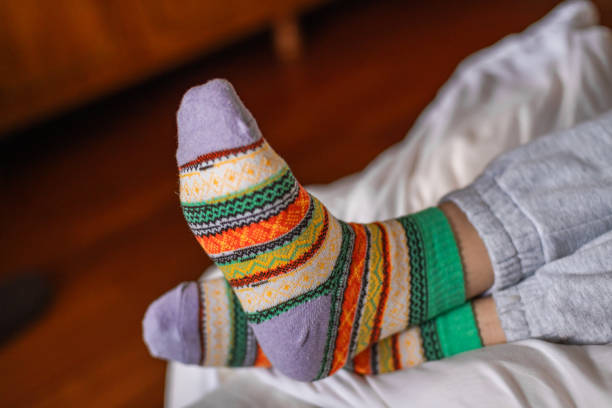Winter adventures demand more from every layer you wear—from your jacket down to your socks. If you're hiking frosty trails, skiing powdery slopes, or exploring chilly cities, one thing becomes non-negotiable: your gear must perform while keeping you safe and comfortable.
That’s where GOTS and OEKO‑TEX certified socks come in. These certifications aren’t just industry buzzwords—they’re a seal of approval for eco-conscious, skin-safe, and high-performance apparel. For the outdoor enthusiast who values both sustainability and comfort, understanding why these certifications matter is key.
In this guide, we’ll explore why GOTS OEKO‑TEX certified socks matter, the benefits of sustainable materials like cotton and cashmere, and how to spot a quality product that keeps your feet happy all season long.
What Is GOTS and Why Does It Matter?
GOTS stands for the Global Organic Textile Standard, the world’s leading textile processing standard for organic fibers. GOTS certification means:
-
The cotton used is grown without harmful pesticides or GMOs
-
Every part of the production—from spinning to dyeing—is environmentally and socially responsible
-
No toxic bleaches, dyes, or finishing agents are used
-
Workers are treated ethically, with fair wages and safe conditions
For outdoor lovers, wearing GOTS-certified socks means you’re reducing your environmental impact without sacrificing performance. In the cold months, this also translates to healthier fabric against your skin, which is especially important for sensitive feet often trapped in boots for hours.
What Is OEKO‑TEX Certification?
OEKO‑TEX® Standard 100 is a globally recognized certification system that tests for harmful substances in textiles. A product that’s OEKO‑TEX certified ensures:
-
Every thread and fiber has been tested for over 100 harmful chemicals
-
The fabric is safe for direct contact with your skin, even for babies
-
There’s full transparency in how the materials were processed and dyed
OEKO‑TEX eco-friendly socks are ideal for winter sports, where foot health and hygiene are paramount. Wearing socks that don’t release irritants or allergens is crucial when your skin is dry, cracked, or prone to blisters during extended cold-weather activity.
Certified Winter Socks vs Generic Synthetics
You might think all socks are the same once they’re inside a boot—but that couldn’t be further from the truth. There’s a noticeable difference between certified winter socks made from GOTS- and OEKO‑TEX-approved materials and generic synthetics.
|
Feature |
Cotton/Cashmere Socks |
Generic Synthetic Socks |
|
Skin safety |
Free from toxins and allergens |
May contain chemical residues |
|
Sustainability |
Made from organic, renewable materials |
Often petroleum-based and non-biodegradable |
|
Moisture control |
Naturally breathable and absorbent |
Can trap moisture, causing odor or blisters |
|
Comfort |
Soft, insulating, skin-friendly |
Often scratchy, static-prone, or stiff |
|
Durability |
High-quality fibers hold shape over time |
Tend to pill, stretch, or thin quickly |
When choosing between natural blown cotton vs synthetic, certified cotton wins for breathability, softness, and long-term performance—especially for sensitive, cold-weather skin.
Sustainable Socks: Cotton and Cashmere for the Win
The ideal fabric blend for winter socks is one that balances:
-
Warmth
-
Breathability
-
Moisture-wicking
-
Softness
-
Stretch and recovery
GOTS- and OEKO‑TEX-certified socks made from organic cotton and sustainable cashmere offer just that. Cotton provides ventilation and structure, while responsibly sourced cashmere adds luxurious warmth without bulk. This combination is perfect for:
-
Winter hikes
-
Après-ski lounging
-
Commuting in icy cities
-
Traveling through cold airports and cabins
For those interested in upgrading their cold-weather gear, explore Polar Star’s certified Nouvelle Collection, which features socks crafted with both performance and environmental impact in mind.
Why Certifications Matter for Eco-Conscious Shoppers
Today’s buyers—especially outdoor enthusiasts—care more about what they wear and where it comes from. Certifications like GOTS and OEKO‑TEX aren’t just labels; they’re trust signals that a product is:
-
Made with respect for the planet
-
Safe for your skin and health
-
Created without unethical labor practices
In winter, when you’re layering up and wearing socks for long stretches, these factors become even more critical. You’re not just buying warmth—you’re investing in quality, ethics, and longevity.
Learn more about the ethos behind these eco-forward values on Polar Star’s story page.
Comfort Meets Consciousness: The Winter Sock Checklist
When shopping for certified winter socks, here’s what to look for:
✅ GOTS or OEKO‑TEX certification tag
✅ Organic cotton or sustainable cashmere
✅ Made in certified facilities with low-impact dyes
✅ Designed for durability and repeated wear
✅ Reinforced heels and toes for rugged use
✅ No synthetic perfumes or finishes
Meeting this checklist ensures you're getting a sock that aligns with your health goals, environmental values, and winter lifestyle.
Health Benefits of Certified Socks in Winter
Winter can be harsh on your feet. Cold temperatures, damp boots, and prolonged wear can lead to:
-
Cracked heels
-
Blisters or sores
-
Dry, itchy skin
-
Fungal infections
Wearing certified socks minimizes these risks by keeping your feet dry, protected, and toxin-free. They:
-
Wick moisture naturally to reduce blisters
-
Breathe easily, avoiding odor-causing bacteria
-
Prevent allergic reactions with chemical-free fibers
-
Regulate temperature more effectively than synthetic alternatives
For people with eczema, sensitive skin, or allergies, OEKO‑TEX-certified socks are a game-changer in winter comfort.
Sustainable Fashion Without Compromise
Eco-conscious doesn’t mean less durable or less fashionable. Today’s sustainable sock brands have mastered the balance of function and aesthetics. Polar Star, for example, offers:
-
Neutral and nature-inspired color palettes
-
Minimalist, sleek designs for everyday wear
-
Reinforced stress zones for added longevity
-
All-season versatility with cold-weather edge
Whether you’re out on the trail or warming up by the fire, you can feel confident that your socks look good, feel better, and align with your values.
Frequently Asked Questions
Q1: Why do GOTS and OEKO‑TEX certifications matter for socks?
Answer: These certifications guarantee that your socks are made without harmful chemicals, with respect for the environment and human labor. They ensure better skin safety, durability, and sustainability—especially important during long winter use.
Q2: Are certified socks warmer than synthetic ones?
Answer: Yes, especially when made with natural blown cotton and cashmere. These materials offer better insulation, moisture control, and breathability compared to most petroleum-based synthetics.
Q3: Can certified socks help prevent winter foot issues?
Answer: Absolutely. OEKO‑TEX certified socks reduce your risk of skin irritation, allergic reactions, and odor build-up. Their moisture-wicking and breathable nature help prevent blisters and fungal issues.
Q4: What’s the difference between GOTS and OEKO‑TEX?
Answer: GOTS focuses on organic and sustainable textile production, from farming to finished product. OEKO‑TEX tests for harmful chemicals and allergens in textiles, ensuring skin safety. Many high-quality socks are certified by both.
Q5: Are certified socks more expensive?
Answer: While they may cost slightly more upfront, certified socks tend to last longer, perform better, and save you money (and discomfort) in the long run. Plus, you're supporting ethical labor and sustainable practices.
Final Thoughts: Choose Better Socks for Your Winter Adventures
As temperatures drop and you gear up for cold-weather fun, don’t overlook what’s wrapping your feet. Choosing GOTS and OEKO‑TEX certified socks isn’t just about staying warm—it’s about protecting your health, supporting sustainability, and enhancing performance.
For eco-conscious adventurers, there’s no smarter winter accessory.
Explore the full range of certified, eco-friendly winter socks in the Nouvelle Collection or learn more about the vision behind the brand on their Our Story page.

